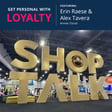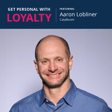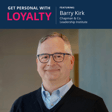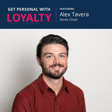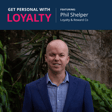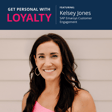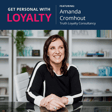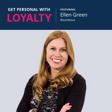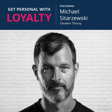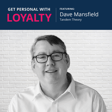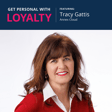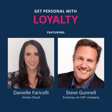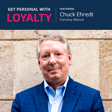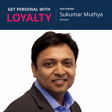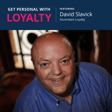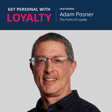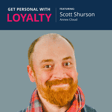Become a Creator today!Start creating today - Share your story with the world!
Start for free
00:00:00
00:00:01

How Media Companies Can Maximize Growth through Loyalty
Accomplished media expert and Director of Agency Partnerships at Annex Cloud, Ray Chelstowski, shares invaluable strategies for transitioning from ad dependency to powerful membership models, breathing new life into customer connections. Discover how top TV networks captivate audiences through gamification. You’ll also learn why loyalty checks all the boxes when it comes to collecting zero-party data, and how to monetize that data and improve ad performance. Listen now to start creating laser-focused campaigns that build emotional bonds while also boosting acquisition.
Transcript
Introduction to Personalized Loyalty Programs
00:00:10
Speaker
Get Personal with Loyalty, where we're discussing using loyalty to deliver personalized, relevant customer experiences. Hello, everybody.
Ray Telskowski's Unique Loyalty Background
00:00:20
Speaker
Welcome to another episode of Get Personal with Loyalty. I'm your host, Erin Reese, and today I'm here with Ray Telskowski from Annex Cloud. He leads our partnership efforts with our agencies. Welcome, Ray. Great to be here.
00:00:36
Speaker
We're excited to have you on today. Why don't we get started and share a bit about your background. You do not have a traditional loyalty background like a lot of the people we talk to. You haven't been in this space for years and years like I have. Instead, you've been more in the media space. You love to hear about your journey and your area of expertise and how you ended up here talking loyalty.
00:01:00
Speaker
So you're right. My background is largely in media and pre-media. And so I worked in the magazine business for many years and ended up being the publisher of Rolling Stone, which was a dream job for me, as well as the publisher of Entertainment Weekly and the Newsweek when it merged with the Daily Beast. And at the time that I became the publisher of these properties, these are brands that were really in transition. They were either celebrating anniversaries or they were launching new products within their brands.
00:01:30
Speaker
or they were in complete turnarounds. And because they had such a high profile, you really put me and the publisher's role and the ability to be in front of people in the C-suite, both at the brand side and at the agency side of a lot of big shops like, you know, River Can and J. Walter Thompson.
00:01:46
Speaker
because everybody wanted to know what the plan was and everybody wanted to know how we were tracking against the plan. And just for a little background, the role of publisher, which doesn't really exist any longer, was really the person who sat on top of the entire business operation, everything from ad sales to marketing to circulation to production, et cetera, that really fell within your purview. And in these roles, it was really important for brands that we worked with, predominantly big blue chip brands like Ford Motor Company,
00:02:13
Speaker
Verizon, AT&T, and others to understand where their dollars were going, et cetera. So a lot of the discussion that we talked about was really about performance and meeting specific KPIs with these brands if they were going to partner with us through these kind of transitional moments. The most recent experience I had within media was sitting on top of a portfolio of about 36 different hyper-vertical special interest brands like Popular Woodworking and Writers Digest and Horticulture.
Transforming Media with Loyalty Tactics
00:02:40
Speaker
Where the mission was to move away from any kind of ad dependency, it really create more of a model where we were creating memberships, where within these subscriptions, if you will, you not only got content from the magazine, but you might get opportunities for e-learning and accreditation and mentorship. There could be obviously discounts on different products, but there was access to things that were central associated with those brands.
00:03:10
Speaker
that membership only allowed for it and when we did that it allowed for us to actually get more and more into what we both understand is loyalty and we were deploying loyalty tactics to get people to migrate from one tier to another and what effectively was
00:03:27
Speaker
a paid subscription model. So when I got into loyalty, it was taking that experience and seeing how you could scale it. How can we start to look at major media brands across every kind of platform, whether it be digital or print or video or even audio. How do we take the success that we have in one and start to scale and really start to see brands, particularly brands that were legacy brands continue to have a relevancy and connect with people and the ways that they always had.
Challenges and Solutions in Streaming Retention
00:03:55
Speaker
Well, as soon as you said membership, I'm like, wait, ding, ding, ding, that sounds like loyalty. You have the background in publishing, but then also media, and you really have a great understanding of that. And from our conversations, it seems to me there's probably many areas of opportunity for loyalty when you think about media, one being entertainment, but even further,
00:04:23
Speaker
I know for a while you were going down a path with different programming from different networks where you could use loyalty to get more viewership and such. That was super interesting to me. I would love to hear what your experience was and what the vision is there and how that could potentially work.
00:04:43
Speaker
So I think that a lot of people who are going to listen to this podcast are probably the same boat as I am. With their cord cutters, if they've had it with their cable company, the way that they watch programming, whether it be in audio or video, is very selective. They want a personalized experience. I like this kind of programming.
00:05:03
Speaker
And so they subscribe to different outlets. The challenge for a lot of networks right now is that they've been able to push forward content from a comprehensive standpoint through a cable provider. And if you like a particular program and it comes to the end of the season,
00:05:19
Speaker
you're not going to cancel your cable subscription because there's hundreds and hundreds of other options for you out there. But if you're one of those people like I am who's cut your cable forward and you've gone to individual streaming providers, all of a sudden now you have a lot of flexibility. If you like stranger things and that season comes to a close, you can decide to cancel your subscription to Netflix and move over to Hulu. And if there's a program on Hulu that you like, as soon as that's over, if you binge watch it in particular,
00:05:48
Speaker
But you can be done in a month. And so what you start to see is tremendous churn within the screening community where people style of programming and they migrate and the contract allows for it, right? You can come in for a month and go out. And that's a very difficult business to manage.
Loyalty Programs in Entertainment Engagement
00:06:05
Speaker
It's a very difficult business for executives to project revenue against because it is so unstable. And they don't know when they introduce a new show, whether or not that's going to launch and have terrific success.
00:06:17
Speaker
So what you're seeing, particularly in big networks like CBS, who are allowed a bit of breathing room at the moment because there is still a big audience, albeit much older, who are still watching primetime television to create an experience that really connects viewers to the programming in ways that we talk about in loyalty.
00:06:41
Speaker
And in short, it's a watch and when. And so in a prior role, I worked with real fortune on the real watches club.
00:06:49
Speaker
in a capacity where we worked in a wire-to-wire relationship with those folks, where we did everything to use the platform, we did the strategy, they used our creatives, they had us deploy all the messaging. We pulled the analytics and we obviously did the day-to-day management of the program. In that relationship, what we were able to do was use loyalty tactics to bring the average age of the viewer down to increase engagement and also
00:07:16
Speaker
create a platform and a tool that Wheel of Fortune could use to recruit all their contestants. So all of a sudden now they were able to go to this one channel and have an understanding of who was going to come through the pipeline, who could potentially be on air. Those kind of metrics we could take to the marketplace and say, what if you were to look at prime time viewing and gamify it?
00:07:39
Speaker
And all of a sudden we started saying at certain strike points in the show, if you say certain things have happened, we can all of a sudden reward you in a way that you hadn't been rewarded before. And we can start to create again, tiers of different kinds of membership. And those points can find opportunities for access to that. That could allow you to get access to viewing parties. It could be to director's cuts. You might be able to participate in a webcast with certain cast members of shows that you like.
00:08:09
Speaker
Obviously, you might be able to get advertiser discounts, but most important for a lot of these people, you get previews to content before anyone else can see it. And that really resonates with the networks.
00:08:19
Speaker
to the point that they also saw the ability that the more that we gamify viewing, the more we can also pad points that you can apply to discounts on premium streaming services. So if you're doing this with CBS, if you've watched CBS part-time programming and are in enough points, you might actually be able to upgrade and get a free subscription to Paramount Plus as well as that.
00:08:43
Speaker
And all of a sudden, you start to not only engage customers, start to transition them to a premium elite program, but you're also capturing data. And I think what the networks also understood was there was an ability to not only gamify their dealing, but gamify other aspects where people engage in a way that they share more about them and what we call zero party data.
00:09:06
Speaker
where they start to create a 360 degree profile of that viewer that they can go back to the advertiser with and go, we can together monetize this and put offers and incentives in front of them about your products and services that we couldn't do before. So I think that a TV standpoint, that's really compelling. It's also compelling from a live entertainment standpoint. Obviously, everybody knows that COVID really had an impact on live entertainment.
00:09:33
Speaker
For obvious reasons, we're migrating away from that and people are starting to go back to see live shows. But one area that there's still a challenge is in indoor arenas, indoor venues. Still outside of the pygmy max like Taylor Swift, they're still having a hard time selling tickets. And as we move into warmer weather, where outdoor venues become more accessible, a lot of indoor venues are starting to see a challenge there about how do I continue to get people to come into our venue. And looking at
Leveraging Viewer Data in Loyalty Programs
00:10:02
Speaker
gamifying and rewarding attendance in ways that really can promote attendance and ensure that on a Wednesday night or on a smaller act that they have a fuller room. Now this could be simple things like
00:10:18
Speaker
Take the video we just posted and share it with your friends. Like the video, watch the video, et cetera. Rewarding behavior that creates more interest in momentum and excitement around an event is something that I think is exciting there. And then the last thing I'll say about it is that in the conversations with network television, when we started going to their advertising agencies and started talking about this capacity,
00:10:44
Speaker
They really got excited about this in an entirely different way. In the advertising business, there's something called a data clean room, where they're using consumer data to reconcile digital ad buys. And so they can say that Erin was someone who we targeted because she fits a certain profile and at a certain kind of capacity to use certain products. And we put an ad in front of her and they use that data clean room to reconcile that they actually delivered against who they said they were going to put the ad in front of us.
00:11:14
Speaker
What a lot of agencies started to see with loyalty data is that it's so rich that it can start to become predictive. And so instead of just saying, you did what you said you were going to do, now we're starting to look at loyalty data and say, it can start to predict what's going to happen. Let's put an ad in front of someone who's about to take a certain act and move in a certain direction.
00:11:37
Speaker
And that, I think, on the agency side, is terrifically exciting and creates a point of difference that helps everybody, particularly their media partners, find ways to engage people in ways they hadn't done before.
00:11:52
Speaker
You've covered so much ground there. It's just amazing. I was taking notes as you were talking, some networks, entertainment venues, and then the ad agencies. But when you were talking about the networks, one of the things I was thinking of is from my background and some of the companies that I've been working with, but it's CPG, consumer packaged goods where they'd never had the opportunity to meet their customer.
00:12:16
Speaker
And they've never
Building Emotional Connections Through Loyalty
00:12:17
Speaker
known where their customer is and they were baking on panel data and whatever they built a brand around in hopes that they knew where their customer was, but they didn't actually know who the customer was. And so when they begin to now collect data through loyalty initiatives and other ways.
00:12:35
Speaker
they're realizing that, oh, my deal demographic might have been female at 25. The reality is I'm getting male at 35 and the data is just eyeopening to people. I never really thought about it from a network perspective, but it's the same thing.
00:12:51
Speaker
The networks are putting out this content. They believe they know the customer is. I'm sure they have some plans as to who they're trying to target and what's happening, but the reality might be different. And even if it's not, still who is that person and how can I connect to your point to keep them coming back to be able to meet their needs more effectively.
00:13:13
Speaker
Yeah, when you think about particularly network television, when the audience that a show like The Equalizer on CBS can deliver in the millionth every week.
00:13:23
Speaker
You're talking about an incredibly broad audience, and it's not like the audience that we were talking about earlier at Popular Woodworking. You're casting a very narrow net there. And so for CBS to be able to take and carve up that group and be able to understand better why people come to that show, what they like about it, what they might like about the star, what they like about the messaging, what they like about the locations in which it's shot,
00:13:48
Speaker
is terrific. And most networks know very little about the reviewer, very little. And all of a sudden to be able to have a 360 degree understanding of why people do what they do beyond the fact that they do it. So for example,
00:14:03
Speaker
If you go to a health club, we know that your health conscious and that you want to be fit. But we don't know necessarily why you may have joined it because you're going to your high school reunion. You may do it because you like going to beach vacations. You may do it literally because you have other health concerns that you want to keep an eye on. And I think that what most marketers, particularly in the CPG field,
00:14:24
Speaker
Our understanding is that there are motivators and there are triggers that drive people to their brands that are broader than they probably understand and there are ways that they can help consumers better appreciate and enjoy and engage with these brands. I think the big change in from a trend standpoint in loyalty.
00:14:45
Speaker
is that we've moved beyond asking people to be loyal to the brand and we're looking for people to be fans and that's why that entertainment notion is an interesting connection right because you're a fan of a show and when you're a fan of programming you like a lot of different things about it.
00:15:01
Speaker
And I think what a lot of brands, particularly in the consumer space, want to do is be the same way. I want you to like me not just because the toothpaste gives you fresh
Advertisers and Networks: A Loyalty Partnership
00:15:11
Speaker
breath. It's also good for your gums. It's this, it's that, it's whitening. I want you to be a fan of this. I just don't want you to like it for one single purpose. And I think that the loyalty initiatives that we see starting to launch allow for that to happen and help facilitate it in a way much more quickly than it's ever been able to do before through technology.
00:15:32
Speaker
Yeah, it's that emotional connection, right? And it's about extending your brand, whatever it is beyond just that experience. So how do I connect better with the toothpaste? And because my smile looks better.
00:15:48
Speaker
It could be the programming, being able to be out with friends, talking about the latest episode. And when your brand is extended into these other points in time of your audience's day in life, that's when you've gotten them. And how do you continue to do that? And then because of ripple effect, because more and more people will come in, they become more connected and they're bringing more people along with them.
00:16:16
Speaker
Yeah, I mean, for networks, what's really interesting is that they have in prime time carryover and the carryover from program to program for the first 15 minutes is something like 70%. It's very, very high. All right. So if you're watching the eight o'clock show, you're probably going to spill into the nine, but all of a sudden now they have an ability to find a way to pull you further into that nine o'clock hour and do things that are different. They tap into things that they know about you and
00:16:46
Speaker
If the data informs that and they can make a prime time loyalty program reward you in ways that are personalized, that's great. And advertisers want to be part of that. You're not going to get emotional about Colgate toothpaste, right?
00:17:02
Speaker
But you can get emotional about Colgate if it's part of the experience that you enjoy with the programming you love, and it does something really special for you. But one of the areas that we really pursued with one of the networks was in the idea of pets, right? So there's this incredible increase in pet ownership during COVID and this connection to pets that has never been, I think, present before.
00:17:28
Speaker
And what if you had an ability to have your pet be part of programming as a loyalty member of Primetime if you could get your dog to have a walk-on role, right, on the equalizer. It's a huge thing. And so there are ways that brands, if a pet smart or a pet co or an alpo, can facilitate that.
00:17:47
Speaker
or a company that Colgate's part of Colgate Palma out of can make that happen. Those are things that all of a sudden connect you more deeply to the show, more deeply to the network, and more deeply to the brand. And that's one of the things that networks are challenged with is that when I grew up, there were networks and you knew the network and you were a fan of the network. So NBC on
Loyalty Programs: Beyond Retention
00:18:06
Speaker
Thursday night was like, that was what we did, right? It was NBC. It wasn't just friends and it wasn't just Seinfeld and Mad About You, it was NBC.
00:18:16
Speaker
This is a way to start to help viewership move back to where they start to look at the provider of the content and their partners and advertisers is rewarding them and being part of an experience, not just that one show. And I think everybody understands that and they know that that's the better future. Otherwise, this trend is just going to continue.
00:18:38
Speaker
Yeah. My mind's going to, okay, great. When are these going to happen? I want to get involved. What fun. And I think it can build a lot of excitement. So super excited. And thank you for sharing all of that insight because I think there's a lot there and hopefully we'll see more of these companies embrace loyalty. One of the other topics that has to do with your background in media is.
00:19:00
Speaker
More companies that utilize loyalty is like a retailer or travel or other organizations. They tend to keep their loyalty program and their loyalty data as this retention effort. It doesn't help with acquisition. It's not really not part of that. And it is like this thing like, oh, I've got a program. I don't have to worry about it. It's running on autopilot. But the reality is there's a lot that program could be providing that can influence
00:19:30
Speaker
other aspects of the business and the way they're purchasing media, the way they're handling their acquisition.
00:19:37
Speaker
Yeah, I think that it's been a really interesting moment because in COVID, what we started to see were people who were adverse to buying online were required to buy online. There was no, I'm going to my brick and mortar the way I always have. And so they were forced to try this. And when many of them did, they looked at it and said, I'm not going back. This is fantastic.
00:20:02
Speaker
I think a lot of brands were awakened to the fact that if they didn't look at loyalty more closely, they would have to be reduced at the lowest common denominator price. I want this product. Who's going to give it to me for the cheapest?
00:20:18
Speaker
And so even brands that had been engaged in loyalty looked at it and said, well, we have to really rethink this. And I think a big change and a big moment, I think there were two of them in the last year and a half that have really made a lot of brands, not just within those categories, sit up and take a closer look, was the launch of McDonald's loyalty program. A year and a half ago, I think it was within eight months, they got 40 million members.
00:20:49
Speaker
And it wasn't as though they were just launching the program and saying we have certain benchmarks that we're trying to meet from a scale standpoint. They had those scale benchmarks matched up with technology and technology deployments that were going to accelerate this and really create a flywheel effect that could completely change the way people look at loyalty, particularly within QSRs.
Digital Transformation in Loyalty During COVID
00:21:17
Speaker
For example, you and I have talked about the fact that they've launched a beta test on drive-through window menus, and that those menus are going to, when you drive through, they're going to capture your license plate, and when you go in and you give your loyalty information, it creates a connection, and that the next time you go in,
00:21:37
Speaker
That drive-through window menu is going to say welcome, Aaron. And it may have specials based upon what you've bought before on your loyalty history. If you've never bought the McWhaler before, there's not going to be a McWhaler there. If you don't like the McRib, they'll McRib. But I think that a lot of industries are starting to take a look at this.
00:21:59
Speaker
And so if we don't start looking more aggressively at how we can take technology and really scale this program that we have quickly, then we're going to be left behind. And it won't just be within our own industry and be in general. There are a lot of things that are happening that start to look a lot like Minority Report with Tom Cruise.
00:22:18
Speaker
In supermarkets, for example, about 10 years ago, it might have been a little less in that there started to be audio services in store that moved well beyond what I grew up with, which is like instrumental versions of modern music that would be played to the store to where you're literally going through an aisle in a supermarket and the supermarket aisle gets a very specific sound, very specific promotional messages, and it's triggered by movement.
00:22:48
Speaker
So it's playing music and somebody goes down that aisle to going down the canned food aisle of a supermarket. It triggers it and all of a sudden now the ads that are served within that space are going to be about canned food. Well, what if when you go into the store and you get the wand and you're going to scan your own food, right? You take your loyalty badge first, now all of a sudden
00:23:11
Speaker
The offers are going to be more personalized, not just going to be about canned food. It's going to be about things that they know you buy, and it's going to be delivered through an audio message directly above you for that aisle alone. If loyalty is moving in that way that quickly, all of a sudden we're migrating certainly from stamp cards and just point statements to a place that's really interesting and exciting. I think that this thing that most brands have to pay attention to,
00:23:41
Speaker
It is probably the most important statistic in loyalty today is that the fastest growth and participation in loyalty is in the 16 to 24 year old demographic. And that's largely because of gamification.
00:23:56
Speaker
And so if you are a brand, I don't care what brand you are, you have an ability to start to get in front of that demographic and start a relationship with them. The lifetime value implications of that with people are extraordinary. Going back 30 years ago, Proctor and Gamble did studies that indicated that people graduated from college.
00:24:16
Speaker
were more likely to buy for the balance of their life, the same detergent their parents bought, the same dishwashing, whatever you grew up with was what you were going to get. If you were a tide house, you were biotied. So that ability to start to establish a brand relationship with an audience, 16 to 24 year old, even if it's just through a gaming exchange,
00:24:37
Speaker
is going to have long-term implications about how they interact with your brand moving forward. So it's a really exciting and dynamic place. And if you're a CMO of the company, you have to look at this and go, it's going to change very quickly. And staying ahead of it requires that not only on top of the best technology, but I have to ensure that the kind of platforms that I work with
00:24:59
Speaker
or adaptable or scalable and to really move with my brand in the way that I want my brand to move. It's an exciting and probably terrifying time for brands and people in charge of those because so much is happening so quickly. And you can't just look at your own lane and go, what's happening at QSR? You really have to look across the entire spectrum and say, who's doing something that I can apply to what my business is about right now?
00:25:27
Speaker
I love how you spoke about it. We both think loyalty and we both talk about it, but you did it in such a different way. It's super interesting and really a data first perspective too, and where the technology can go. And we're certainly seeing that. I was talking to somebody earlier today. She has been at a brand, various brands for a long time.
00:25:50
Speaker
The challenges of just connecting the data points. And so he would say, well, she's slow. Well, she takes time and it's important, but it's going to be a while before you see results. And I would always argue that, no, you can move quickly. But the reality is you needed the technology to be able to do that.
00:26:10
Speaker
And I think 10-15 years ago we didn't have that and now technology has accelerated and you're right through COVID people have done the digital transformation so they're more ready to be able to do more with the data that they're collecting and be able to deliver different kinds of experiences.
Zero Party Data and Personalization Trends
00:26:29
Speaker
I would love to get some more of your insight just from your background is we're collecting more data on customers, zero party data and being able to know more about customers. There's more ways to use it than just, hey, I know Ray and so I'm going to give him a better experience, but I can use that to support my merchandising. I can use it to support my real estate purchases or the next location that I want.
00:26:59
Speaker
But it also can help me with where and how I'm spending advertising. Advertising organizations leaned more on like third party data and look alike and more panels versus true who is my customer. And is that something that you're seeing too? So yeah, I think that
00:27:23
Speaker
There's a big change today in terms of loyalty because people are starting to understand that loyalty can be applied in a lot of different ways. There are, I think, two ways to look at that. And from a brand standpoint, it's kind of like the space race, right? Who's going to get there first and who's going to figure out how to do these things?
00:27:41
Speaker
There used to be, from an advertising perspective, agencies were full service agencies. So if you watched Mad Men, that's what a full service agency was. They did strategy, they did creative, they bought media, they actually purchased sponsorships for brands. They really sat at the top of the relationship with a brand manager in that brand and really guided everything that it did.
00:28:04
Speaker
That changed probably 20 years ago, and Asia too saw that they could actually pitch pieces of this business and build out separate enterprises. And so all of a sudden, what was a really cohesive and strategic and direct relationship with the client
00:28:20
Speaker
became broken up into a lot of different pieces. You had a digital buying agency, you had a creative agency, you had a strategy agency, you had an intervention. And it all started doing their own thing. And sometimes the messaging that they did was very specific to what they were doing. So there wasn't an umbrella campaign. I grew up with brands where it was their slogan and it was everywhere. And somehow it cascaded down into whatever it was. It wasn't an effort, it was this and that.
00:28:49
Speaker
We're watching loyalty really take off for a lot of the reasons what we talked about at the very moment that you're starting to hear about the death of the cookie, right? And that Google and others are walking away from basically trailing you and everything that you do in desktop or in mobile across the web.
00:29:09
Speaker
And the data that companies have been able to glean from your traffic about you is the very thing that everything that brands do is being executed against. And that's in jeopardy. And what we're hearing from a lot of agencies that's much different than they've seen before are two things in every request they have for a new business pitch. One,
00:29:32
Speaker
is that they can take every dollar that they recommend a client spend, and whether it's media, sponsorship, et cetera, can be tied back to some form of attribution, whether it be sales or a specific KPI, like raising awareness of a brand or improvement of approval rates against certain demographics about social awareness, et cetera.
00:29:53
Speaker
The other side of it is, what are you going to do for me to help me ready for a moment where I don't have access to that third-party data, where I need to establish a data capture protocol, a zero data capture protocol that I don't have in place right now? Because
00:30:11
Speaker
I need to have that to better understand how I put messaging in the marketplace and actually move the needle in all the different places that those needles have to move. So I think that it's an interesting point right now where when you start to look at third party data, brands and agencies alike
00:30:30
Speaker
have to look at it and say, OK, if we're going to capture it, it's going to really inform everything we do. And the quickest way to capture it, the easiest way to capture it, and the way that in capturing it actually rewards customers, actually gets them excited about brands, because through loyalty.
00:30:49
Speaker
And so we're seeing that very quickly where people, I don't want to use the word scramble, but they're hurrying their efforts to get to a place where they can say, all right, I've got a plan in place or I'm helping like close, put it in place. Because when this goes away, it's gone. And if you've got breathing room at that breathing room right now is saying you've got 12 months because Google is saying they're pulling their pretty cookies next year.
00:31:16
Speaker
In 12 months, you can very effectively capture an amount of data that puts you in a safe place and probably a better place than you are today to talk to your customers, but you have to do that now. And so I see in talking to C-suites, agencies, and C-level people, clients, and brands.
00:31:35
Speaker
This is a major concern. There have been some relief because Google's pushed this further down over the last three years. But it's going to happen. And if you don't have a plan in place, you're going to be left behind. And even if you have the best technology in place, even if you have a great strategy, if you can't execute that strategy against the right audience, it's not going to deliver the kind of results that you're looking for.
00:32:00
Speaker
Great points and loyalty is a really great solution, obviously, is what you're saying. And one of the points that I always emphasize with loyalty is you get consent because there's a lot of ways to collect data from customers. You see a lot of gamify spin and wins and I get an email and that type of thing, but you're not
00:32:26
Speaker
getting the consent. And I guess there's also a commitment when somebody joins a loyalty program. It said, yes, you can speak to me. And yes, because there's going to be that reward that you talked about, I will promise to raise my hand when I'm interacting with your brand. So there's only a loyalty strategy is going to give you those two components that I think are really imperative for long term success.
00:32:57
Speaker
Yeah, the number one reason people drop out of loyalty programs is not that they don't want to be in a loyalty program. It's because they're not receiving offers and incentives that matter to them, that they're going to act on. And conversely, the number one reason loyalty programs fail is they run out of money because they're giving you incentives for things you didn't need an incentive for. You were going to buy it anyway. You need an incentive for something else.
00:33:20
Speaker
I think that what we're seeing in almost every article that you read about loyalty is personalization. And the idea of customizing offers for people that match up to their needs and their moments is important.
Cross-Brand Promotions with Loyalty Data
00:33:34
Speaker
And the trade-off in that, the consent is that I will give you more information if that results in you giving me offers and incentives that are more tailored to me.
00:33:43
Speaker
Be relevant. Yeah. I mean, I think that one of the things that development and loyalty that I think you're starting to see it take off in elite programs like Advantage from American, but this idea of earn now, pay later, right? Where I know you're spending a certain amount of money with me every year, right? But right now you're buying something and what you're going to buy is either going to be with me or with someone else based upon an incentive.
00:34:11
Speaker
If I know you to get there, what if I gave you the incentive in advance, and if you actually hit that reward level and you do it earlier, I'm going to give you even more. And that's the advantage program, right? So you can only do that based upon data. You can only do that based upon really understanding what people want and that you're putting things in front of them, they're going to add the funds. And so
00:34:32
Speaker
I think it's exciting for folks because the data isn't just about modeling. It's not about looking at lookalikes. It's about, I raised my hand, I said this about me, and we're going to engage and we're going to embark on something together that's going to be rewarding for both of us.
00:34:49
Speaker
That's terrific. It goes beyond what's happening today with some things like Siri, where sometimes I feel like I'm talking about a product and the next thing I know on my iPhone, I'm seeing an ad. And I'm like, boy, I feel like somebody's listening to me. That's not what I call me raising my hand. Me raising my hand is I'm sorry about myself. And we got an open relationship. And that, when you took them to take a look at CLV, that's going to expand that in really meaningful ways.
00:35:14
Speaker
Yeah, that's a fabulous point. You talked about that earlier. You were talking about having the data.
00:35:22
Speaker
and enough of it to now be predictive. And just because you heard somebody or Siri heard us talking about something doesn't mean that it's relevant or it's something that you want. But when you're actually providing the data about who you are, what your intent, your intention is, or what your wish list is, and then
00:35:45
Speaker
In turn, the brand is being proactive and speaking to you in that fashion. It goes a really long way. And frankly, I think we've got a long way to go as organizations out there today. I think the technology is there. It would be nice to see more relevancy, but from everything you're talking about, it sounds like we're getting there. The ultimate expression of this, and I think we're going to get there.
00:36:08
Speaker
is where you start to use the data to inform partner marketing in a way that's really effective. And we all went, right? So I use this example of I'm a member of the Nordstrom program. I'm also a member of ACE hard risk program, right? And those are two brands that probably wouldn't park and market together. They would never think that they shared me, but what if they did know that they shared me? What if they both knew that about me?
00:36:32
Speaker
and that when I go to Nordstrom and I go to buy clothes, they know if I don't complete the transaction with a certain amount of time, I'm going to abandon the cart. At that moment in time, what if Ace Hardware was able to put an offer in front of me to complete the Nordstrom's transaction? A $20 gift card for Ace.
00:36:51
Speaker
Um, I look at this and go, wow, you guys both understand me better than anybody does. This is awesome. I'm going to ACE this weekend. ACE knows that I'm going to probably spend more than $20 like us in the store, right? They got in front of me in a place that they typically couldn't. Right. And I'm over here buying shirts and they're offering me an opportunity to go to the store. Um, I feel rewarded in the best cases for Nordstrom.
00:37:13
Speaker
I completed the transaction. They didn't have to fund the incentive. And best yet, the incentive didn't devalue the brand. If this isn't $20 off their shirts, this is $20 in a different store, right? And so everybody at this relationship wins. It is informed by loyalty and loyalty data.
Exploring Non-Traditional Loyalty Applications
00:37:32
Speaker
Yeah, that's like mic drop. We talk about partnership a lot, but the way you just described it really creates the impact and it's not, I think a lot of times you can think about partnership and it's soft. It's a little more fluffy. It's making somebody feel good about the brand. Not that that's not good, but this is really actionable at a real relevant point in time.
00:37:56
Speaker
And I think that a fabulous point and a fabulous way to look at what loyalty can do and what you can do with a partnership. If you're thinking beyond typical and really thinking about how you can use the data and really changing people's behavior of it. Right. This has been a fabulous conversation. So much loyalty data, where it's going and where we can be. And it's really amazing. Any parting guidance or advice for the audience?
00:38:26
Speaker
Yeah, I had this moment where I recently just got a new wallet and it was one of those moments where you empty your current wallet out and you go through. I can't even believe I had this in here.
00:38:37
Speaker
And I had a loyalty card for a coffee shop that I used to use in your city buried in there, which was a stamp thing. And I always stopped going into Manhattan a couple of years ago, all right? And that was still something that many, many very hip-happened shops were using. Loyalty is expanded very quickly. And I think that what's most exciting to me is that if you're in an industry that you don't think loyalty has an application,
00:39:06
Speaker
You really ought to talk to us because it's in those places that you can probably have the most impact. We're seeing a lot of interest in associations and healthcare providers. We're seeing how do I get loyalty tactics to get people more engaged with our initiatives, our companies and what we're trying to do. We don't sell products, right? I sell services, but we realize that this is the behavior that people are adopting and using.
00:39:32
Speaker
So why not have them do what they're doing and have it be for our benefit as well and reward them for it? I think that it's an exciting time. I think if 16 loyalty programs that the average adult is part of now, it could be as many as 32. And if you have a thought about it, you have questions about it, you ought to be talking to us because I think that we probably have some ideas that if this conversation inspires you, we can keep that going. Oh, sad. And to that point, Ray, why don't you tell people how they can get ahold of you?
00:40:03
Speaker
So you can reach me at my email address here, which is a mouthful. It's R. Jill Stavsky, my last name, R-C-H-E-L-S-T-O-W-S-K-I at annexcloud.com. Also on LinkedIn and every social platform and pushing content out about loyalty on a regular basis. If you see me there also, probably feel free to share the stuff, reach out and happy to talk to you about what we talked about today and anything in my background that you think might have an application.
00:40:33
Speaker
Great. Thank you, Ray. And I second that. Please follow him. He does have amazing content. Thanks so much, Ray. Great chatting with you today. Likewise. Thanks for listening to this episode of Get Personal with Loyalty. Join us next time for more loyalty insights. Until then, dare to dream. Let AnnexCloud help make your dreams a reality. Visit annexcloud.com. See you soon.
